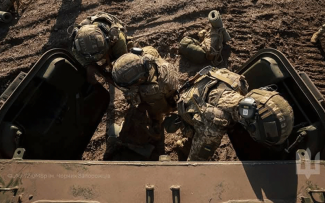Russia pushes Ukrainian forces out of Russian territory. Day 1161 of the war

![]()
On 26 April, Russian troops seized the centre of the last Ukrainian-controlled village in Kursk Oblast – the border town of Gornal. This gave Vladimir Putin and the army’s Chief of General Staff, General Valery Gerasimov, the basis to declare the end of the operation to drive enemy forces out of the Russian Federation (from the Kursk and Belgorod oblasts). This in turn – paradoxically – confirmed that Moscow does not yet de facto consider the annexed regions of Ukraine to be part of Russia. Kyiv announced that reports of Ukrainians being pushed out were untrue, and that the operation on Russian territory was ongoing. The authorities were supported in this by some reluctant military commentators, with OSINT there disagreeing in its assessment of the situation.
Ukrainian soldiers are most likely still holding out in the forested areas on the border of the Kursk and Belgorod oblasts, but they no longer control any village or infrastructure facility. According to DeepState on 28 April, there was still 29 km2 under their control in Russia, however this figure should be considered an overestimate. Indeed, by 27–28 April at the latest, the Ukrainians had been driven back from the last positions held in Gornal and Oleshnya, which lay slightly further north. Holding both villages exceeded their logistical capabilities (there is no road connection to them from the Ukrainian side).
The presence of Ukrainian troops on Russian territory can currently only be seen as a diversionary activity. The creation of a grouping that would allow a renewed incursion into the Russian Federation seems to be beyond the capabilities of the army, especially as it would have to be much stronger than the one used in the attack on Kursk Oblast in August 2024.
The Russians are continuing moves to create a ‘buffer zone’ in the border area of Sumy Oblast, but have failed to make further progress. Four villages are most likely under their control there, but any reports on this are denied by Kyiv, and the Russian-occupied areas are most often presented as a combat zone. Control of the information is aided by the total evacuation of the population from the border areas of the oblast which was carried out in previous months.
In other areas of the fighting in Ukraine, the invaders have made further advances, but these still do not change the overall situation. The front from the northern outskirts of Toretsk to the Pokrovsk-Kostiantynivka road remains particularly active, with Russia moving towards the latter in several places simultaneously. It has also pushed the defenders out of the next positions between Velyka Novosilka and Pokrovsk, in Chasiv Yar, east of Siversk and north of Lyman. However, its attempts to seize and hold positions in Mala Tokmachka east of Orikhiv in Zaporizhzhia Oblast failed.
![]()
On 24 April, the Russians launched another massive attack, with Kyiv and Kharkiv as their main targets. According to Ukrainian data, Russia used 72 missiles (initially the Air Force Command reported 70) and 145 drones, of which 48 and 64 were shot down respectively. A further 68 drones were claimed as locationally lost without negative consequences. Kyiv’s Antonov facilities were hit and, according to some sources, Artem as well. One of the ballistic missiles used, a North Korean KN-23, hit in the Sviatoshyn region. Russia damaged 54 buildings, 12 people were killed and 87 injured. In total, 106 structures are thought to have been impacted in the capital, with the total number of injured estimated at more than 100. In Kharkiv, around 20 explosions were reported, with the Malyshev plant being one of the targets. Damage, especially to industrial, storage and railway infrastructure, was also reported from Zaporizhzhia, Pavlohrad (chemical plants were hit) and the Kharkiv, Khmelnytskyi, Kyiv and Zhytomyr oblasts.
On 28 April, Russian drones hit a gas infrastructure facility in Cherkasy. Six people were injured and 117,000 consumers were temporarily cut off from gas supplies. One day earlier, drones hit Dnipro, Odesa and Zhytomyr, Kharkiv on 25 and 26 April, and Kyiv on 29 April. On 23 and 26 April, missiles fell on Sumy Oblast. Again, the number of strike drones used by Russia began to increase. According to Ukrainian data, from the evening of 23 April to the morning of 29 April, they deployed a total of 777 of them. 305 are thought to have been downed and 327 locationally lost. The enemy is thought to have used 80 missiles during this period (including the 24 April attack), of which 48 were declared shot down.
![]()
The 28 April attack resulted in a fire at a fuel base in the Novorossiysk region of Krasnodar Krai. Some sources claim that Neptune cruise missiles were used. On the same day, Ukrainian drones targeted the microelectronics-producing Kremny El plant in Bryansk, but there is no information about hits. This facility had already been successfully attacked in January this year, and earlier in October 2024. According to the Ukrainian General Staff, damage to the unmanned drone manufacturing plant in Yelabuga, Tatarstan, occurred as a result of a drone strike on 23 April. By contrast, the biggest Ukrainian attack on Crimea in many months, in which 60 drones were used, according to Russian data, and the strike on a refinery in Ryazan Oblast on 29 April were unsuccessful a day later.
On 25 April, a bombing took place in the village of Balashikha near Moscow, killing Lieutenant General Yaroslav Moskalik, deputy head of the Main Operational Directorate of the Russian General Staff, who was involved in planning Russian military operations in Ukraine. A day later, the Federal Security Service announced the detention of 42-year-old Ignat Kuzin, accused of carrying out the attack on behalf of Ukrainian special services. On 28 April, President Volodymyr Zelensky confirmed their involvement in the attack.
![]()
By the end of April this year. Kyiv will receive 400,000 artillery shells under the so-called Czech Ammunition Initiative, Czech Defence Minister Jana Černochová announced in an interview with CNN on 27 April. This means that the donation may be smaller than in 2024, when 1.5 million shells were given to Ukraine as part of the initiative. Denmark, meanwhile, will set aside €42 million for artillery ammunition for the country – to be distributed for purchase through Estonia.
![]()
The newly formed 8th Air Assault Corps (AAC) of the Ukrainian Armed Forces included six brigades, including the only artillery brigade in the AAC. Colonel Dmytro Voloshin, previously commander of the 82nd Air Assault Brigade, took command. The units have been taken over from the 2024 7th. AAC, formed in January. 7 AAC Corps, bringing together all brigades of this type of army. After the formation of the 8th AAC Corps, four brigades and an independent regiment remained in the 7th. Most of the support and security subdivisions remained outside the structure of the corps, in direct subordination to the Air Assault Forces command (only the reconnaissance and unmanned aircraft battalions were transferred to the 8th, with a command battalion remaining in the 7th). This means that the organisational transformation did not entail a qualitative change and both corps still remain de facto dependent as units to perform operational tasks.
In 2024, military spending accounted for 34% of Ukraine’s GDP – the highest percentage for this purpose in the world. In absolute numbers, it was $64.7 billion. This is according to an assessment of global military expenditure published by the Stockholm International Peace Research Institute (SIPRI) 28 April. Compared to 2023, it has increased by 2.9 per cent and, according to the institute’s experts, it will be difficult to increase it further. All of the state’s tax revenue is thought to be used for military purposes.
On 24 April, the Ukrainian government simplified procedures related to the import of explosives and components for the manufacture of ammunition, including 155 mm calibre. This is intended to facilitate contracting by manufacturers – the need to sign state contracts will disappear. The aim of the changes is to accelerate the supply of explosives and support ammunition production.
On 28 April, Commander-in-Chief of the Armed Forces of Ukraine Oleksandr Syrskyi stated that there are many unresolved problems with basic general military training. It is apparent that there are shortcomings in adapting the programme to the realities of the battlefield and a deficit of suitably qualified instructors. Syrskyi pointed to the need to create an information and analytical system that would take into account the experience of units fighting on the frontline in the training process.
![]()
According to SIPRI, Russia, which remains in third place in terms of military spending (after the US and China), was thought to have spent USD 149 billion in 2024 – 38% more than the year before. This amount represented 19% of the federal budget and 7.1% of GDP.
On 23 April, the independent Russian new website Important Stories reported that more than 1,500 foreigner citizens from 48 countries had undertaken contractual service in the Russian army in Moscow between April 2023 and May 2024. Data on them was obtained by hacking into a medical database. The largest number came from South East Asian countries – 771 (including 603 from Nepal, indicating that Russia has ignored protests from that country’s government calling for an end to recruitment). From countries formerly part of the USSR, 523 were recruited, mainly from Tajikistan, Uzbekistan, Kyrgyzstan, Kazakhstan and Belarus (71). Seventy-two were recruited from Africa (primarily Ghana, Cameroon and Senegal) and 71 from the Middle East (including Egypt and Iran). A small number of mercenaries came from European countries. Although the disclosed information does not cover all recruitment points in Russia, it shows that the army there is not giving up on the ad hoc replenishment of losses with poorly trained foreigners from countries with high poverty and unemployment levels.
On 28 April, the leader of North Korea Kim Jong Un publicly confirmed the participation of the country’s soldiers in an operation to push Ukrainian forces out of Kursk Oblast. He stressed that the presence of North Korean servicemen in Russia had strengthened the strategic military partnership between the two countries, which he described as “the highest level of brotherly relations”. The dictator regarded North Korea’s participation in the operation as a “sacred mission”, in line with Article 4 of the Comprehensive Strategic Partnership Treaty between North Korea and Russia (see ‘Russia signs a military alliance with North Korea’), committing the parties to mutual military assistance. A memorial will be erected in Pyongyang to commemorate North Korean soldiers participating in the fighting against Ukraine. On 26 April, Russian Chief of General Staff Gerasimov announced the end of the ‘Kursk operation’ and emphasised North Korea’s role on the frontline. This may mean that their contingent will be withdrawn from combat operations, but it is not a foregone conclusion that they will leave Russian territory. The Ukrainian General Staff claims that more than 4,500 North Korean troops have been ‘neutralised’ since the start of the operation.






